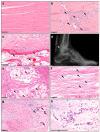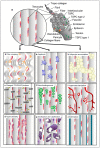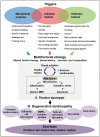Spectrum of Tendon Pathologies: Triggers, Trails and End-State
- PMID: 32013018
- PMCID: PMC7037288
- DOI: 10.3390/ijms21030844
Spectrum of Tendon Pathologies: Triggers, Trails and End-State
Abstract
The biggest compartment of the musculoskeletal system is the tendons and ligaments. In particular, tendons are dense tissues connecting muscle to bone that are critical for the integrity, function and locomotion of this system. Due to the increasing age of our society and the overall rise in engagement in extreme and overuse sports, there is a growing prevalence of tendinopathies. Despite the recent advances in tendon research and due to difficult early diagnosis, a multitude of risk factors and vague understanding of the underlying biological mechanisms involved in the progression of tendon injuries, the toolbox of treatment strategies remains limited and non-satisfactory. This review is designed to summarize the current knowledge of triggers, trails and end state of tendinopathies.
Keywords: risk factors; tendinitis; tendinopathy; tendinopathy management; tendinosis; tendon pathologies; tendon rupture.
Conflict of interest statement
The authors declare no conflict of interest.
Figures



References
-
- Frankewycz B., Penz A., Weber J., da Silva N.P., Freimoser F., Bell R., Nerlich M., Jung E.M., Docheva D., Pfeifer C.G. Achilles tendon elastic properties remain decreased in long term after rupture. Knee Surg. Sports Traumatol. Arthrosc: Official J. ESSKA. 2018;26:2080–2087. doi: 10.1007/s00167-017-4791-4. - DOI - PubMed
Publication types
MeSH terms
LinkOut - more resources
Full Text Sources
Medical

